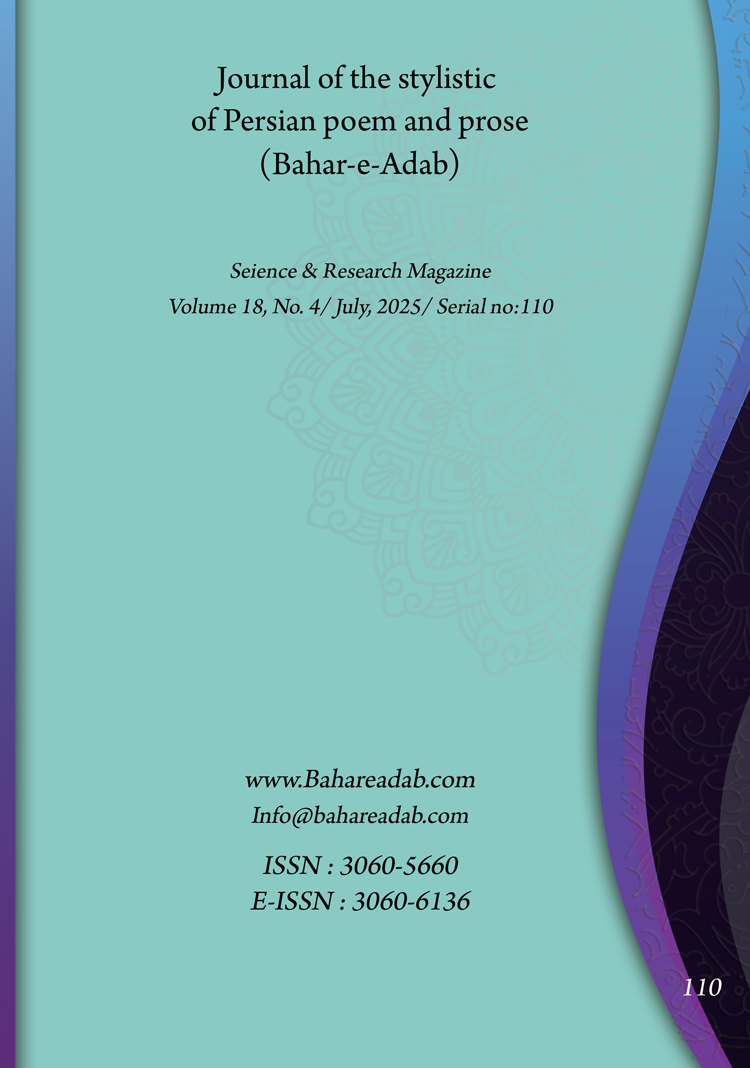- Count View : 119
- آدرس کوتاه شده مقاله: https://bahareadab.com/article_id/1840
- کد doi مقاله: Doi: 10.22034/bahareadab.2025 .18 .7853
Journal of the stylistic of Persian poem and prose
volume Number 18،
number In Volume 4،
،
issue Number 110
Decoding the aesthetic role of commercials
Mahmoud Fazilat (Author in Charge), Frank Shojaei Bahabadi
Abstract
BACKGROUND AND OBJECTIVES: Commercial advertising is a form of communication that tries by using attractive methods persuades the audience to buy goods and use services , and today it has the largest amount of advertising in the world. Designers of advertising messages, with relative knowledge of the audience, seek to use methods that the intended message should be attractive and impressive so that they can have the desired effect on the audience. They have found that direct and simple reference to the topic is not relevant to the audience and is quickly forgotten. As a result, they are looking for methods that make the message appear unclear, meaningful and impressive. One of the most important of these methods is the use of language tools and facilities. Advertising designers use rhetorical arrays, including puns, repetition, similes, etc. in their ads. They are more effective. In this research these arrays have been examined in two groups, verbal and spiritual, in commercials and slogans.
METHODOLOGY: The research method in this study is based on the research-analytical method and the method of collecting information is through library study and collecting commercials used in the media, including radio and television, newspapers, and magazines.
FINDINGS: By studying commercials, it has been found that their designers have used all linguistic possibilities and rhetorical devices in creating these types of messages. it has been determined that among the verbal arrays, rhyme (saj") and among the spiritual arrays, amphibology (iham) has the highest frequency in commercials
CONCLUSION: The use of Language facilities and rhetorical arrays in the text of commercial messages and advertisements, in addition to creating beauty and attractiveness in them, also ensures the permanence of the product name. It also presents the message to the audience indirectly by creating ambiguity and multiple meanings, which attracts the attention of the audience and encourages them to buy the advertised product or use the services mentioned in these commercials.
Keyword
rhetorical arrays
, commercials
, advertising
, audience
, verbal arrays
, spiritual arrays.
- Baba pir Ali, Somaye (2018) The role of media literarcy in audience analysis and modeling of persuasive television advertising, Media management, Number 43, November, pp 91-110
- Payandeh, Hossein (2006) New methods of literary criticism and cultural studies, Tehran, Shahr, p 47
- Dad, Sima (2013) Dictionary of literary terms, Sixth edition, Tehran, Morvarid, p 416
- Sojoudi, Farzan (2016) Applied semiotics, Fourth edition, Tehran, Elm, pp 261-264
- Shafiei Kadkani (1996) Imagry techniques in persian poetry, Sixth edition, Tehran, Agah, pp 99-139
- __________ (2012) Poetry music, Thirteenth edition, Tehran, Agah, p 99
- Shamisa. Syros (2007). A fresh look at the Innovation. Tehran. Mitra. pp. 33-131
- Salehi Mazandarani, Mohammad Reza, Seyd Mohsen Zakinejhadian (2017) The role rhetorical and linguistic functions in commercial advertising, Two quarterly scientific research journals linguistic and rhetorical studies, Eigth year, Number 16, Fall and Winter, pp 223-250
- Safavi, Koorosh (2000) An introduction to Semantics, Tehran, Hermes, pp 229-241
- Fazilat. Mahmoud (2011) A Language of Image (Science of Expression and Structure of Literary Images). First Edition. Tehran. Zavar. pp 133-134
- ------- (2012). Innovative Structures. Tehran. Yadvare Ketab .p 59
- Ghahramanloo, Roxana (2008), Metaphor in advertising, Faculty of Visual Arts University of Arts Ministry of Science, Research and Technology, To the guid Kamran Afshar Mohajer
- Mohabati. Mehdi (2007). New Innovative (The art of constructing and arranging speech), Tehran. Sokhan. pp 67-137
- Mohsenianrad, Mehdi (1999) Communication studies, first edition, Tehran, Soroosh, p 43
- Vahidian Kamyar. Taghi (2011). Innovative from an aesthetic point of view. Tehran. Samt. pp 17-123
- Hashemi, Simin (1391) Examining the interaction between literary devices and cultural and commercial advertising, Faculty of Visual Arts University of Arts Ministry of Science, Research and Technology, pp 41-140

